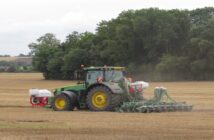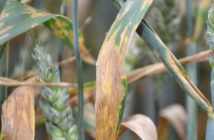The AHDB/HGCA Winter Planting Survey shows a greater reliance on spring cropping by the arable sector for harvest 2015 in England and Wales.
By 1 December 2014 the area planted to wheat, winter barley, oats and oilseed rape totalled 2.776M ha, 5% less than the total area of these crops harvested in 2014.
As planting conditions were relatively favourable last autumn, this change is likely driven by economic and agronomic factors. This is in contrast to plantings for harvest 2013, where poor autumn conditions led to more spring cropping.
Helen Plant, AHDB/HGCA Senior Analyst said: “Potential factors include increased interest in cultural controls for weeds and diseases, particularly black-grass, as well as changes to the economics for the whole rotation. The higher yields of winter crops are worth comparatively less at lower prices – increasing the incentive to plant spring crops.
“The introduction of the three-crop rule as part of the latest changes to the Common Agricultural Policy may also have had an impact.”
Wheat was planted on an estimated 1.69M ha as at 1 December in England and Wales. This represents a drop of 7% compared with the area of wheat harvested in 2014, but does not take into account any late winter or spring wheat plantings.
Late winter and spring plantings are gaining attention due to their potential contribution to black-grass control and so are likely to become more important to the total wheat area. The largest declines are seen in the East, South East and East Midlands, which perhaps reflect the strength of the challenges posed by black-grass in these regions.
Winter barley plantings remain high in England and Wales. An estimated 0.371M ha was planted by 1 December, broadly in line with the area harvested in 2014 and the largest since 2003. The total UK barley area will depend on plantings this spring.
Ms Plant added: “The winter barley area remains historically strong in England and Wales, with plantings again seeming to benefit from the availability of newer high-yielding varieties. We may also be seeing a high winter barley area due to farmers looking to extend their rotations, widen their harvest window and spread workloads. Again, many growers this year may be using winter barley to support the establishment of following oilseed rape crops.”
The oilseed rape area is estimated at 0.633M ha as at 1 December. This represents a small (1%) drop from the total area of oilseed rape (both winter and spring varieties) harvested in 2014.
While overall the oilseed rape area remains relatively strong and is only slightly lower year-on-year, there seems to be a regional spilt. Declines to the oilseed rape area in the south and east of England, are offset by increases in the north of England. This is perhaps linked to the large winter barley areas planted in the north of England for harvest 2014, an ideal preceding crop for oilseed rape.
The oat area as at 1 December shows a 23% decline from the total oat area harvested in 2014. With the English and Welsh oat area estimated at 85K ha by 1 December, this places higher emphasis on spring oat plantings this year.
The fall in the area planted to oats was widely anticipated following large crops in both 2013 and 2014, with a subsequent decline in prices for crops not grown on contract. Nonetheless, it should be remembered that spring oat plantings, especially in the north of England and Scotland are important to the national total.
The winter planting survey results are available in an interactive format through the HGCA Market Data Centre.
This survey, which measures autumn crop planting up to 1 December 2014, is based on 2,152 responses from a representative sample of farm businesses. The areas reported by these businesses equates to 9% of the estimated area of wheat, winter barley, oat and oilseed rape planted in England and Wales as at 1 December.
Results for smaller crop areas such as oats should be treated with additional caution as they are subject to a higher level of uncertainty.
Full analysis of the England and Wales planting results, plus data from the Scottish Government, will be published in a Prospects article on hgca.com/markets on 31 March 2015.
AHDB/HGCA will carry out a full planting and variety survey this spring on total areas for harvest 2015, with results released in the summer.



